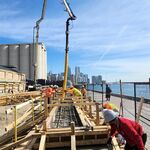Euphoria
Active Member
The current elevated Gardiner and the Hybrid Gardiner East plan are pure mediocrity and always will be. People on here whine about the expense of Boston's Big Dig, even though we'd face half the challenges of that project and our tunnels would pale in size by comparison. The facts on the ground are that they pulled it off; we didn't. The seam that once existed in that city is disappearing beneath infill projects, public art, markets, and greenery. Grow a pair and achieve one great project for the city that isn't a another watered down box in the sky by a private developer. The Rogers Centre and CN Tower are getting long in the tooth...





